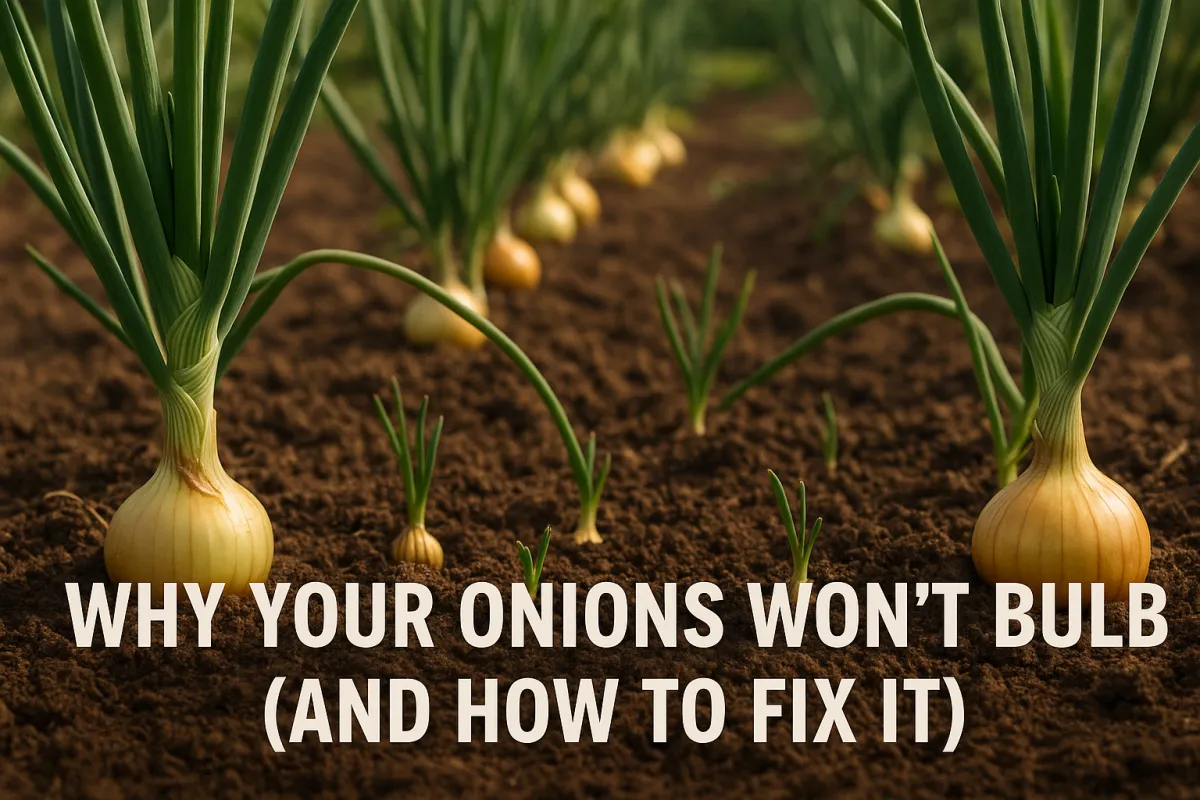
Why Your Onions Won’t Bulb (and How to Fix It)
Why Your Onions Won’t Bulb (and How to Fix It)
The Year My Onions Stayed the Size of Marbles
I still remember yanking up a bed of onions one summer and staring at a basket full of marble-sized bulbs. All season long I’d watered, weeded, and fussed over them, expecting fat, round onions like you see at the market. Instead, I ended up with nothing worth slicing. That was the year I learned something every gardener faces sooner or later: onions don’t just grow bulbs because you want them to. They need the right conditions, and if you miss them, you’ll end up with skinny tops and tiny roots.
By the end of this guide, you’ll know exactly why your onions aren’t bulbing—and how to fix it so you can harvest big, healthy bulbs next season.
Understanding Onion Bulbing Basics
Onions go through clear stages:
Seedling stage – sprouting and establishing roots.
Leaf growth – producing green tops.
Bulbing – the plant responds to day length and starts swelling its base.
Curing – drying down into a storage-ready bulb.
The key shift happens at the bulbing stage, and it’s triggered mainly by day length and timing. If either is wrong, the plant simply won’t bulb. That’s why choosing the right onion type and planting window matters most.
1. Wrong Day-Length Type for Your Zone
Onions respond to daylight hours, not just heat or soil. Plant the wrong type for your region and you’ll fight a losing battle.
Short-day onions (bulb at 10–12 hours of daylight) thrive in the South.
Intermediate-day onions (bulb at 12–14 hours) work in middle zones.
Long-day onions (bulb at 14–16 hours) are for the North.
If you live in Michigan and plant short-day onions, you’ll get leafy greens and no bulbs. Likewise, a Texas gardener planting long-day onions will never see proper swelling.
Grandma’s Tip:
“Plant the onions that fit your daylight, not your wish list.”
2. Planting Too Late or Too Early
Timing is everything with onions. They need to put on strong leaf growth before the bulbing stage kicks in. Plant too late and they’ll bulb while still too small. Plant too early and cold stress or bolting (flowering too soon) can ruin your crop.
Spring planting: Works best in northern climates for long-day onions.
Fall planting: The way to go in southern zones with short-day onions.
A good rule: if your onions look weak when the days start stretching out, you planted too late.
3. Overcrowding and Shading Issues
Onions need space and sunlight to bulk up. If they’re packed too tightly, they’ll compete and stay small.
Proper spacing step-by-step:
Plant sets or transplants 4–6 inches apart.
Keep rows 12–18 inches apart.
Thin seedlings once they’re 3 inches tall.
Also watch what’s growing nearby. Corn, tomatoes, or even tall weeds can cast too much shade. Onions want full sun, all day.
4. Nutrient Imbalance — Too Much Nitrogen
It’s tempting to keep feeding onions with nitrogen fertilizer because it makes the tops lush and green. But that same lush growth comes at the expense of bulbs.
High nitrogen = leafy growth, small bulbs.
Balanced feeding = steady tops, strong bulbs.
Switch to a balanced fertilizer (something like 10-10-10) once the plants are established. Stop nitrogen-heavy feeding when bulbing begins. That’s when the plant needs energy to swell the base, not grow more leaves.
5. Stress Factors That Stop Bulbing
Even if you’ve nailed variety, timing, and nutrition, stress can still shut down bulbing.
Drought: Onions have shallow roots that dry out fast.
Heat spikes: Sudden temperature jumps can stall growth.
Root damage: Aggressive weeding can cut fragile roots and set plants back.
Pro Tips (Avoid These Mistakes):
Never let onions go bone-dry during bulbing. Keep soil evenly moist.
Mulch lightly to hold moisture and stabilize temperature.
Weed gently—don’t yank. Loosen soil with a fork instead.
Region-Specific Notes
USDA Zones 3–5 (North): Plant long-day onions in early spring.
USDA Zones 6–7 (Mid): Use intermediate types; spring and fall crops are possible.
USDA Zones 8–10 (South): Short-day onions do best when planted in fall or winter.
Planting the right type at the right time for your zone is the single biggest fix for small or no bulbs.
Faith in the Seasons
Gardening teaches patience. You can’t rush onions, and you can’t bend day length to your will. It reminds me of Ecclesiastes 3:1 — “To everything there is a season, a time for every purpose under heaven.” Trust the process, plant in season, and the harvest will come.
Pulling Up Full Bulbs Next Season
If your onions won’t bulb, it usually comes down to five culprits:
Wrong day-length type.
Missed planting window.
Overcrowding or shading.
Too much nitrogen.
Stress from drought, heat, or root damage.
Fix those, and you’ll be pulling up heavy bulbs instead of marbles.
👉 To make it simple, I’ve put together a printable Onion Planting & Bulbing Calendar by Zone — so you’ll never wonder which type to plant, or when.


Facebook
Instagram
X
Youtube